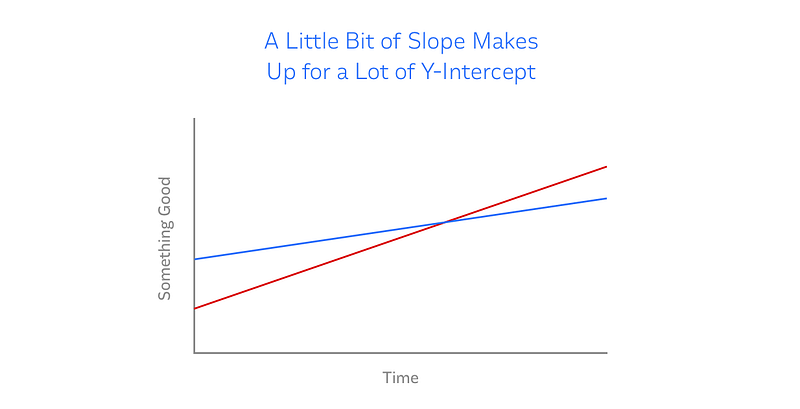Forget about big companies. Heck, things that work at one startup don’t often work at a different one!
Modern and smart startups interview differently
Smart startups realize that every startup is different in some way. From team, process, leadership & culture this difference may mean that an otherwise stellar candidate may still perform terribly at a job at their specific startup.
Here is how normal startup design their hiring process:
Smart startup realize that this process doesn’t work since it is generic and doesn’t ensure a tighter fit between the company and the candidate.
These startups don’t do generic interviews. They don’t ask skill related questions, give hypothetical case studies or ask logical puzzles. They do their homework and carefully plan each step in the process to get one step closer to establishing a fit.
Example of Intercom
Intercom has custom designed their interview process. And since it has raised $243M so far and has 30000 paying customers, the hiring process must be working for them.
This is how Intercom has described how they hire engineers. It’s a great read.
Basically their process involves:
- Asking to build working prototype of a product
- Once it’s done, letting candidates choose the next set of features
- Pairing candidates with Intercom engineers
While these look to be regular steps, they are not. They are designed by Intercom to fit their very own engineering process and culture.
Let’s take a closer look
- The first step is to check how quickly someone can build a working product (the very first MVP). They believe in shipping features fast and this step ensures that the candidate can make quick choices about building a product.
- The second step is to understand the true bend of the candidate’s mind. Do they seek more features, better architecture, performance, UX or something else. There is no right answer here — just some important cues on where to fit the candidate if hired.
- The third step is to check collaboration and team work. Intercom’s engineering culture is focusing on your strengths while borrowing from team where you’re weak. This is a costly step for Intercom, since their engineers have to spend active time on this. Yes, this step would ideally be only needed for the most promising candidates, still it’s big cost. It just shows how seriously they take their hiring.

It should now be clear — Intercom has designed the hiring process uniquely for their company. Same process might not work at Google or Airbnb, which might have different organizational context.
Intercom is too big. Alright, here is another example
Since Intercom has $243M funding and 100+ solid engineers, you might say their case study doesn’t apply to smaller startups.
Fair enough. Let me take a different example. Of our own startup.
At CutShort, our context is quite different from Intercom but one thing is common — we also take our hiring seriously and would rather not hire than hire someone who is not a great fit.
Over a period of time, we have changed our interview process as well. It used to be generic and focused more on testing skills. But now, it’s less about testing skills and more about making the candidate work in as real life conditions as possible to see if they have the key ingredients.
[mautic type=”form” id=”5″]
An example of hiring a Customer Success Manager
Recently, we were hiring for Customer Success role. This is how we did it.
After the above two steps, we knew we needed to hire for this role. We had done this role for 6 months so we also knew some basic ingredients. But in the context of achieving a better team fit, we again discussed the role and agreed on these competency areas:
- Product understanding
- Customer Empathy
- Organized, good memory and desire to close things fast
 After vetting the candidates over a phone call, we decided to go for onsite coworking. We got the candidates in our office and worked them with our team for 2.5 days. Every day, we carefully planned a set of activities that focused on one of the above key competency areas.
After vetting the candidates over a phone call, we decided to go for onsite coworking. We got the candidates in our office and worked them with our team for 2.5 days. Every day, we carefully planned a set of activities that focused on one of the above key competency areas.
While spending time on these, the candidates also got a first hand understanding of the team, the culture, the product and basically everything the job would be about. This helped them take the right decision as well.
When we closed the role and the person accepted, we were much more confident about our decision that we were ever before.
Also read: How to get more responses to your job applications?
Summing up
So often, we all subconsciously pick a hiring process that we followed at a previous company. Some of us just copy the process followed by companies such as Google or Dropbox.
That’s a mistake. Every startup is unique and should be their hiring processes. The business context is different — some have to optimize for velocity, some for technical accuracy, some for scale and so on. This “context” changes the kind of teams you want to build and the kind of people you want to hire.
Haven’t done this? Start now! Sit down with your team and think about your business context. What kind of people you would need to hire? What attributes they should have? And then design your hiring process to reflect that.
Have done this? Please share how you did it and we would love to add your example to this blog. :)’



